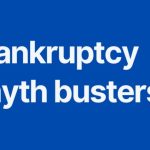In ancient times, a debtor who was unable to pay his debts was considered a felon or a virtual slave of his creditors. Many were incarcerated and could be released only when they could pay their debts. In certain instances, an unfortunate debtor even suffered the penalty of capital punishment!
Fortunately, times have changed majorly since then (in Australia, debtors’ prisons were abolished in the mid-19th Century). However, there is still a lot of stigma – not to mention many misconceptions – surrounding bankruptcy.
Bankruptcy is one type of a formal personal insolvency administration. It can be intimidating and confusing for many people, so let’s unpack some of the misconceptions – including the one that it’s only criminals that go into bankruptcy.
1. If you’re a bankrupt, you’re a criminal
Surveys have shown many people believe bankruptcy is a criminal action or involves criminal behaviour. But the reality is that bankruptcy often results from the overuse of credit, poor health, or bad luck. Bankruptcy can happen to anyone. People generally file due to reasons beyond their control – not because they are dishonest and trying to avoid their creditors.
2. You’ll lose all your assets
This is a common fallacy. The Bankruptcy Act 1966 defines assets within two categories:
- Unprotected (‘divisible’) assets available to a trustee Assets such as shares, valuable antiques and artwork, lottery winnings, cash at bank, cryptocurrency / digital assets, copyrights, boats and jet skis. Some of the most significant unprotected assets people own include residential or investment properties.
- Protected (non-divisible) assets not available to a trustee Protected assets typically include superannuation (although there are some special circumstances), general household contents and furniture, some compensation or life insurance payments, tools used to maintain employment worth up to $4,200*, and vehicles (cars or motorbikes) used primarily for transport, worth up to $9,100*.
Note: cash up to the value of $3,000 is generally left by the trustee to pay for general living expenses.
*this amount is updated each financial year
3. You can’t travel or work overseas
While travelling overseas is more difficult if you’re bankrupt, it’s not impossible. You must request permission from your trustee to travel (it’s an offence to travel overseas without receiving written consent from the trustee), and you do need a valid reason to make the trip. You’re also able to work overseas if you receive your trustee’s consent. If your trustee is the Official Trustee, you’re required to pay a non-refundable application fee of $150.
Note: your trustee may hold your passport during the bankruptcy period while you’re residing in Australia.
4. If you have a job you can’t file for bankruptcy
The reality is that many employed people do file for bankruptcy. However, you’ll need to review your work contract and any associated license to check if any of your employment conditions are affected. Also, particular industry associations may impose restrictions or conditions if a member becomes bankrupt.
5. You can’t earn money when you’re bankrupt
There’s no limit as to how much you can earn whilst in bankruptcy. However, you might be required to make income contributions towards the bankrupt estate if your income is above the indexed threshold. Currently, if your after-tax income is above $68,768.70 (or approximately $90,000 before tax) and you have no dependents, you’re required to contribute half of any income over this threshold. The threshold* increases if you are taking care of dependents.
Note: a person is classified as a dependent if their income is less than $4,253. This amount is updated each financial year.
*the threshold is updated every March 20 and September 20.
6. You can’t apply for credit
You can obtain credit below the amount of $6,771* without telling your lender about your bankruptcy status. And once your bankruptcy has ended, which is generally three years and one day from when your bankruptcy application was accepted, there is no restriction on applying for loans or credit. Credit reporting agencies keep a record of your bankruptcy for:
- five years from the date you became bankrupt; or
- two years from when your bankruptcy ends, whichever is later.
*this amount is updated quarterly
7. You still have to pay your debts
That’s not the case. Almost all your debts will be captured by your bankrupt estate except for fines, child support and some other debts that sit outside the bankruptcy regime. Neither you nor your spouse will be liable – although your spouse could be liable if you both jointly and severally liable to the debt or if your spouse signed a guarantee to pay your debt.
8. Being bankrupt means you’re a failure
For many, filing for bankruptcy is the best decision they can make. The bankruptcy law in Australia is designed to alleviate debt in a structured and monitored way. Clearing this debt and starting again is important for people’s mental health as once this stress is gone, you can work on a financial plan for your future in a less stressful environment. Rather than being a failure, bankruptcy is a sensible way to get your life back on track and allows you to move forward with your life.
Don’t delay seeking help
It’s important to remember that you don’t have to deal with bankruptcy on your own. The worst thing to do is not tell anyone. There are professionals who can give you the financial advice you need, and it’s important to remember that emotional support is also vital.
If you or your client are in financial distress and need guidance about what your options are, we have six bankruptcy trustees and specialist teams who can help. Please don’t hesitate to reach out for an obligation free consultation.

Victor Vuong
Supervisor
Jirsch Sutherland











